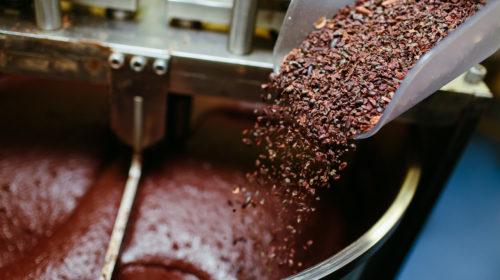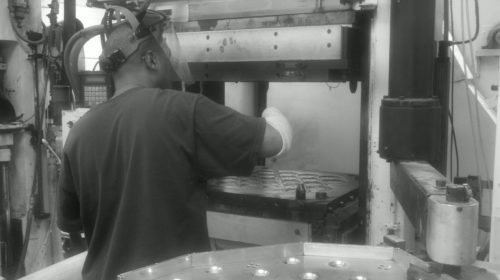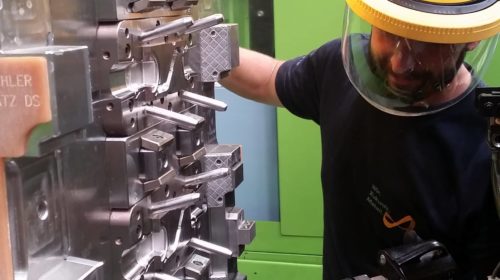
Medical device manufacturers experience improved product quality and reduced scrap rates
THE SITUATION
When it comes to medical device manufacturing, precision can be an understatement. Paying attention to the intricacies in molding catheter tips and surgical equipment, grinding needles and tubes, or coating stents is critical as the end product must be pristine and uncompromised. Like the end product, the tools and equipment used in the manufacturing process must also be maintained and the finishing process must ensure that the products are delivered without flaws or excess material and ready for use.
THE PROBLEM
Medical device manufacturers face many challenges when it comes to cleaning and maintaining equipment and deburring or deflashing products. Many of the innovative parts and products produced by manufacturers are small and the equipment is finely detailed and expensive. Residue build-up in the extremely small mold cavities and on the expensive tooling during the production of the high tolerance medical device parts can impact the quality of the end product. This build-up results in parts not meeting tolerances, which elevates scrap rates, and could eventually clog the mold cavities and impede the performance of the tooling. The residues can also prevent the imprinting of small, yet critical details, such as measuring scales on syringes.
Because of the small size of mold cavities, and in many cases, the delicate nature of the equipment, the cleaning process is typically labor intensive. The high tolerances on the parts also require stringent quality controls, which means the cleaning process has to equal the manufacturing process in terms of quality and diligence. To clean and maintain the equipment and parts, manufacturers have tried a variety of cleaning and finishing methods.
TRADITIONAL METHOD
Medical device manufacturers have experimented with several cleaning processes for their complex needs. Examples of the methods they have tried include:
- A catheter tip manufacturer used isopropyl alcohol and brushes to clean the part’s small mold cavities. The process was slow and labor intensive, often inconsistent and inadequate. In addition the direct contact with the molds frequently placed the expensive equipment at risk of damage.
- Another catheter tip manufacturer had to cool, disassemble and rinse its molds. Each cavity was manually drilled and examined under a microscope. The molds then had to be reassembled and reheated before production.
- A medical stent manufacturer used a micro sandblaster to remove residue from expensive clamps during the production of high tolerance parts. The tooling had to be disassembled prior to cleaning, and the abrasive blasting process rapidly wore down the tooling. After 2-4 cleanings, sandblasting destroyed the clamps. The sandblasting also created substantial secondary waste.
- A medical manifold manufacturer would disassemble its molds, let them soak in oven cleaner and then scrub them to remove build-up. Following the cleaning, the molds had to be dried, reassembled and reheated.
- When it came to product finishing, or deburring and deflashing, one surgical instruments manufacturer used manual scraping to remove burrs and excess material, while another used micro sandblasting. The manual process was slow and laborious, and damaged parts, while the abrasive sandblasting was harmful to some delicate parts and created secondary waste that needed to be treated as toxic materials.
THE SOLUTION
In each of the previous examples, the manufacturers replaced their manual and abrasive cleaning and finishing processes with an alternative cleaning method called dry ice blasting. The precision cleaning method uses recycled CO2 in the form of dry ice pellets or pieces accelerated at supersonic speeds to delicately remove residue from parts and equipment. The process is helping medical device manufacturers to improve quality, increase production, prolong equipment life, improve worker safety, reduce costs and support environmental initiatives.
Improving Quality
Cleaning the manufacturing equipment and products is critical when producing medical device parts. Unwanted material can build-up in the tiny and detailed molds, and must be removed. When grinding needles or laser-etching holes and slots, burrs can form, which require deburring. Any clogging reduces airflow and can damage the parts, which then must be scrapped.
Other cleaning methods, such as sandblasting, chemical solvents and manual scraping, chipping, drilling and scrubbing with brushes are time consuming as cleaning a single mold can require up to an hour or more, including the disassembly and reassembly of equipment. In addition to being physically demanding on maintenance workers, these traditional cleaning methods can damage the equipment and are not completely reliable.
Improving Productivity
Medical device manufacturers are discovering that cleaning with dry ice can reduce cleaning time by as much as 75 percent. For example, one person using a precision dry ice blasting system at a manifold manufacturing plant was able to clean a mold in 15 minutes versus an hour with a previous method. The reduction in time can save manufacturers thousands of dollars in time and labor costs.
Cleaning molds and equipment is simplified with dry ice blast cleaning as the equipment can be cleaned in place, eliminating cooling, disassembly, reassembly and reheating from the cleaning process, and reducing the risk of damaging the equipment. Unlike abrasive cleaning methods, the combination of the kinetic and thermal gradient effects breaks the bond between the residue and the surface. When the dry ice hits the surface it sublimates, or returns to its gaseous state, eliminating any secondary waste. After sublimation, the miniscule contaminants fall to the floor or are captured in a HEPA filter.
Prolonging Equipment Life
Dry ice blasting delivers a complete clean without the abrasiveness of more aggressive sandblasting or manual scrubbing, or the corrosiveness of harmful solvents. Equipment life is extended as regular, thorough dry ice blast cleaning does not carry the risk of damage that often occurs with disassembly and transporting equipment to designated cleaning areas. Unlike sandblasting, there is no media that can get trapped in tight spaces within the equipment and cause damage.
Improving Worker Safety
Dry ice blast cleaning is safe for operators and eliminates unnecessary exposure to harmful solvents and the need to work closely with extremely hot equipment. The user-friendly cleaning process also eliminates the repetitive motions of manually cleaning that can cause carpal tunnel and operator fatigue.
Reducing Costs
Medical device manufacturers using Cold Jet dry ice blasting systems have reported a dramatic reduction in equipment downtime. This is attributed to the fact that the dry ice blast cleaning process can be performed with the equipment still online and without damaging equipment. Labor costs for cleaning delicate molds are also reduced by using dry ice blasting as the cleaning can be done by one person with a single cleaning system. Additional cleaning expenses associated with traditional cleaning methods, such as purchasing rags, hand tools and solvents, are also reduced.
A catheter tip manufacturing company in Minnesota that uses dry ice blast cleaning to clean molds experienced a 40 percent reduction in total cleaning time while another device manufacturer saved more than $75,000 by eliminating the need to replace expensive clamps that were destroyed following 2-4 cleanings with a sandblast cleaning system.
Supporting Environmental Initiatives
Dry ice blast cleaning is an environmentally responsible cleaning process that supports the green initiatives of medical device manufacturers. Dry ice blast cleaning eliminates the need for chemical solvents, and because the process does not produce any secondary waste, it also reduces the possibility of downstream contamination.
THE BENEFITS
Demands of the medical device market often push back scheduled cleaning, which can have both short and long-term implications for manufacturers. Unless molds and equipment are consistently and properly maintained, production and quality may suffer in the short-term, while the equipment life may be cut short or plagued with constant repair. Dry ice blast cleaning allows manufacturers to clean faster and more frequently, which will help them to consistently produce high quality results while also extending the life of their most valuable and expensive equipment. Most importantly, the ability to clean quickly and in less time allows manufacturers to get back to producing products and growing the bottom line.
Dry ice blast cleaning has proven to be faster, safer and more effective at removing materials used during the manufacturing process. It will not wear away at metal surfaces, alter the shape or fit of molds or damage the equipment in any manner. The process provides manufacturers with a more effective cleaning option to replace messy sandblasting and the arduous task of manually scraping or drilling. Manufacturers that have already integrated dry ice blasting into their cleaning processes have experienced a reduction in labor time and costs, eliminated secondary waste and implemented an environmentally responsible process that promotes a safer and healthier work environment for employees.

